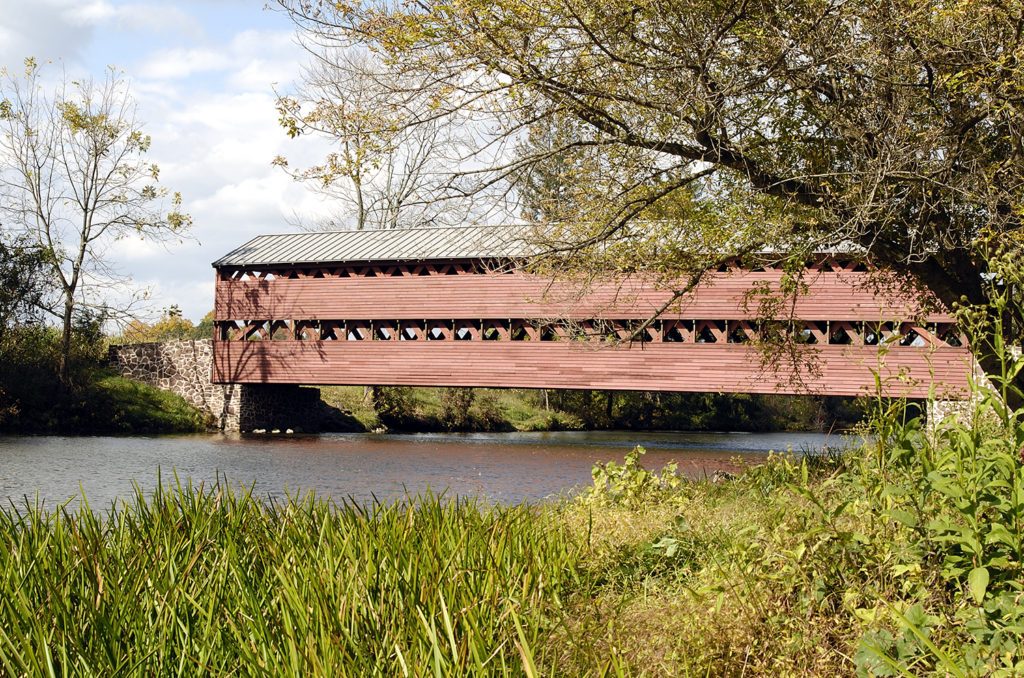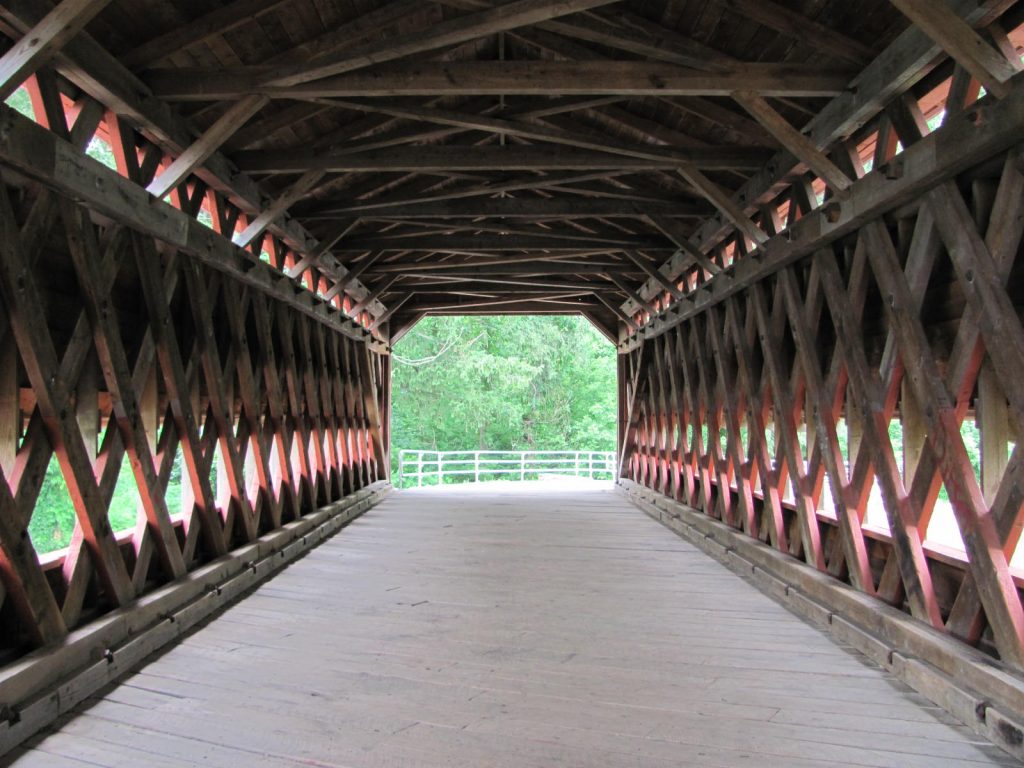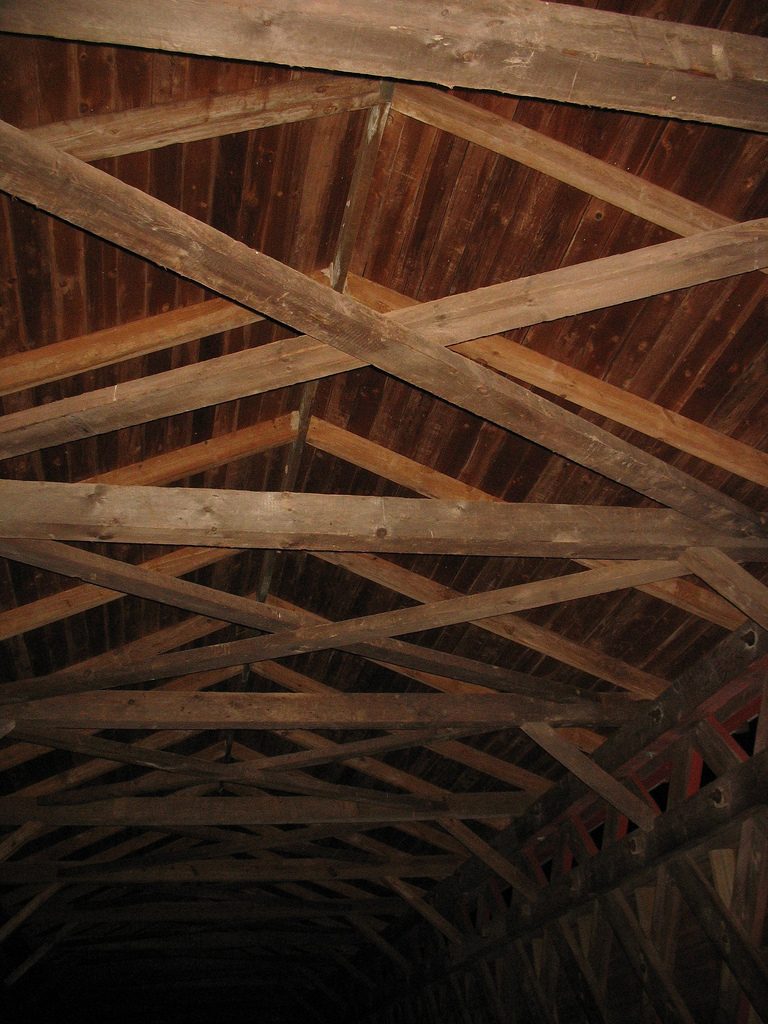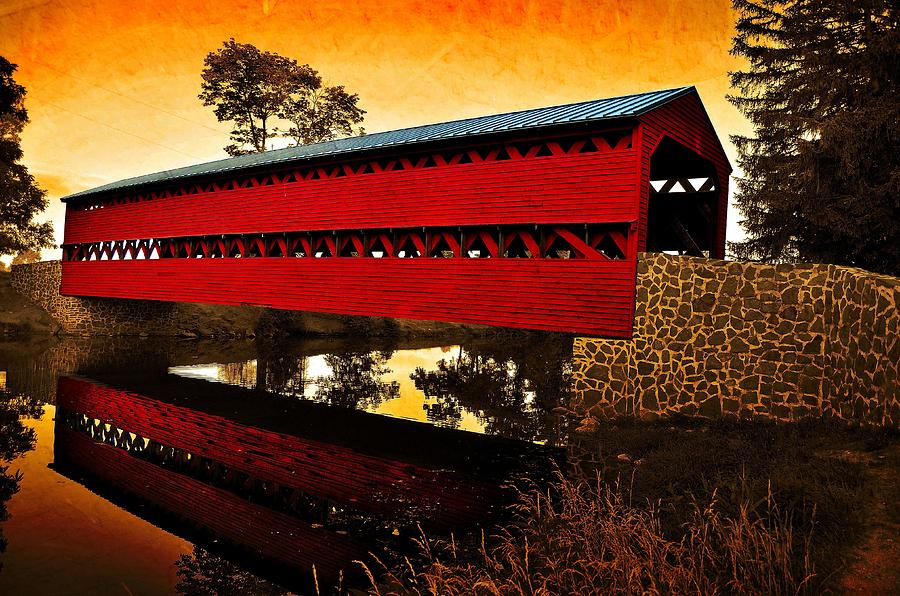To one side of the town proper of Gettysburg, is a beautiful old bridge crossing the Marsh Creek, between Cumberland and Freedom Townships in the State of Pennsylvania. Its construction is distinct. Built in 1852, the one-hundred-foot Sachs Covered Bridge is a town-truss bridge, an architectural design patented by Ithiel Town in 1820. Town became rich off his patent. It was said he charged as high as two-dollars a foot in royalties for his designs, but the bridge became famous. (1) One of the few remaining truss town bridges in Pennsylvania, it was designated the state’s most historic bridge in 1938. (2)

At the time it was built, it must have been an engineering marvel to the farmers and townspeople of Gettysburg. Instead of heavy piers, the supporting frame was built with wooden beams, plank floors and extensive lattice work that could be made from whatever wood was available. It could be assembled by laborers. Its structural integrity allowed large volumes of traffic, including heavy wagons, to cross over without peril.
The picturesque bridge didn’t dwell in domestic peace for very long. Only a decade after its construction, Pennsylvania was at war with the newly formed Confederacy. Robert E. Lee’s army had already swept over Virginia, securing Chancellorsville in a bold move that caught the larger Union army by surprise, by splitting his troops into two separate invasions. Confident he could continue gaining ground in the north, Lee began his march to Gettysburg.
Lee’s plan depended greatly on the element of surprise. On the first day of his advance, his troops met with the Union’s Army of the Potomac and mounted an aggressive assault for the town of Gettysburg. If it had just been Meade’s army he had to contend with, it’s possible Lee would have secured the town. By the second day of fighting, he had managed seize much of the town, despite heavy losses, but Lee had lost the element of surprise. By July three, Lee’s army had just fifteen thousand able-bodied troops and the northern Union battalions began pouring in from every side. (3)
Two brigades of the First Corps Union army marched across the bridge on their way to Gettysburg during the first day of fighting. It was also used by the Union III Corps on their way to Black Horse Tavern. Four days later, his army in tatters, Robert E. Lee and his troops used the bridge as they staged a hasty retreat in the rain and fog. (4)

The bridge appears to be a conduit, linking the past with the present. Thousands of footsteps marched over it during those four days of battle and the sound of that steady march still seems to echo from the floorboards.
Walking through one hundred feet of covered bridge can be a daunting experience. The past clings to the one hundred-seventy- year-old boards. Occasionally, mysterious vapors will waft out from the latticework orbs will appear, floating near the ceiling. Neither the vapors nor the orbs are camera-shy. Both have been caught on camera by visitors. (5)

Visitors have reported hearing the distance sounds of cannonballs and battle cries while crossing the bridge. Others have seen ghostly figures sharing a cigarette or standing guard near the exit. One recognizable ghost is Robert E. Lee, who is said to stand by one side of his bridge, smoking his pipe as his army slips away into the fog.Midway through your supernatural journey across the bridge, you might begin feeling cold spots and ghostly touches. You might smell cigar smoke and hear disembodied voices. It’s as though the bridge recorded a memory of those fateful days and brings those memories back to when it was young and filled with glory. Neither good nor bad, just a remembrance of when thousands of feet strolled across the bridge, filled with resolve and purpose.
One of the most prevalent stories, told by locals and visitors alike, is a grisly one. Many have witnessed the apparition of three soldiers who had been hung from the rafters of the covered bridge. There are two versions of who the hanged men were. Both stories are plausible. In one story, they were deserters, caught and hung by the Confederacy before continuing their flight into Virginia. The other is that they were Confederate spies, caught by the Union and hung for treason. Hanging men don’t talk. They only leave their reminder that death came by a rope instead of a bullet. (6)
Whether you’re a skeptic or a believer, the Sachs Covered Bridge is remarkable. Its history gives it a life of its own. Its lattice truss design is a study in elegance and has proven to be so well-integrated, not even a major flood, over a hundred years later, could destroy it.
The bridge is so sturdy, it remained open to vehicle traffic until
What motivated these ghosts to seek asylum on a bridge that has gone from horse and buggy days to automobile

Battle noises, apparitions, hanging men, disembodied voices, ghostly touches and the lingering smell of cigar or pipe smoke have all been reported by visitors and locals who dared to walk across Sachs Covered Bridge. (8) Some insist the spirits are more prevalent at night, while others state the time of day doesn’t matter. Either the bridge itself or the spirits within it, have moods, with hair-raising experiences occurring on some days and complete tranquility on others. Sightings have been so frequent, they have even been shouted out at ordinary social media sites as well as in ghost-hunting circles.
Even historians are baffled by the number of people who swear they have had a supernatural experience on the bridge and diligently mention that the Sachs Covered Bridge is not only America’s most historic bridge; it is America’s most haunted. (9)
- https://en.wikipedia.org/wiki/Ithiel_Town
- https://en.wikipedia.org/wiki/Sachs_Covered_Bridge
- https://www.history.com/topics/american-civil-war/battle-of-gettysburg
- http://www.waymarking.com/waymarks/WMHPHX_Sachs_Covered_Bridge_Gettysburg_PA
- https://www.quotev.com/story/5416370/Ghost-Stories-and-Folklore/8
- http://explorepahistory.com/hmarker.php?markerId=1-A-201
- http://www.waymarking.com/waymarks/WMHPHX_Sachs_Covered_Bridge_Gettysburg_PA
- https://www.pahauntedhouses.com/real-haunt/sachs-covered-bridge.html
- http://www.scenicusa.net/010713.html

This protection helps cowl someone else’s bodily injury
or property damages when you’re decided to be at fault for the accident.
The policyholder could rent their very own public adjuster to barter the settlement with the
insurance company on their behalf.